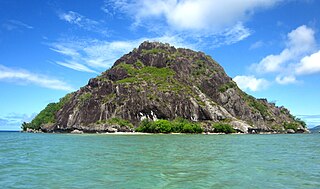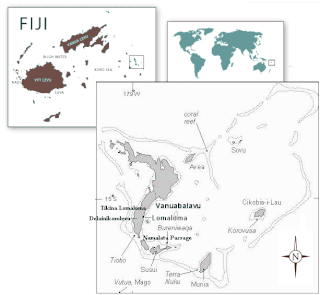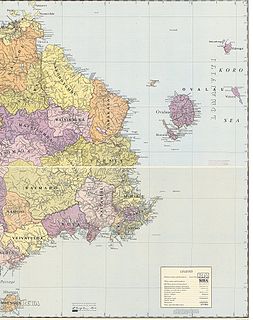
Adi Koila Mara Nailatikau is a Fijian lawyer, who has served as a diplomat and politician. She was also First Lady of Fiji from 2009 until 2015, as the wife of Ratu Epeli Nailatikau, the President of Fiji.

Brigadier-General Ratu Epeli Nailatikau, CF, LVO, OBE, MSD, KStJ, is a Fijian chief who was President of Fiji from 2009 to 2015. He has had a long career in the Military, diplomatic service, and government. From 2001 to 2006 he served as Speaker of the House of Representatives – the lower and more powerful chamber of the Fijian Parliament. He was also the Chairman of the Parliamentary Appropriations Committee and of the House Committee. On 8 January 2007, he was appointed the interim Minister for Foreign Affairs and External Trade; he was moved to the post of interim Minister for Provincial Development and Multi-Ethnic Affairs in September 2008. In October 2008, he became Indigenous Affairs Minister "and effectively Great Council of Chiefs chairman". On 17 April 2009, he was appointed Vice-President by the Military government.

Articles about people, places, things, and concepts related to or originating from Fiji, include:
Ratu Sir Penaia Kanatabatu Ganilau was the first President of Fiji, serving from 8 December 1987 until his death in 1993. He had previously served as Governor-General of Fiji, representing Elizabeth II, Queen of Fiji, from 12 February 1983 to 15 October 1987.
Ratu (raatuu) is an Austronesian title used by male Fijians of chiefly rank. An equivalent title, Adi, is used by females of chiefly rank. In the Malay language, the title Ratu is also the traditional honorific title to refer to the ruling king or queen in Javanese culture. Thus in Java, a royal palace is called "keraton", constructed from the circumfix ke- -an and Ratu, to describe the residence of the Ratu.
Fiji Week was a week of prayer meetings and multicultural programmes that took place the week of 4–11 October 2004. Organized at a cost of US$410,000 by a multiracial national committee chaired by the Prime Minister, Laisenia Qarase, Fiji Week was intended to foster reconciliation among Fiji's diverse ethnic communities, especially native Fijians and Indo-Fijians, whose mutual rivalry for political power has dominated Fijian politics for the last generation, and whose relationship has been especially strained since the overthrow of the Indo-Fijian-led government of Mahendra Chaudhry by ethnic Fijian nationalists in the Fiji coup of 2000. Organizers of Fiji Week hoped that it would help to bring about a sense of closure to those events, but the controversy that it generated made this appear difficult to achieve.
Tovata is one of three confederacies comprising the Fijian House of Chiefs, to which all of Fiji's chiefs belong.

The Lau Islands of Fiji are situated in the southern Pacific Ocean, just east of the Koro Sea. Of this chain of about sixty islands and islets, about thirty are inhabited. The Lau Group covers a land area of 188 square miles, and had a population of 10,683 at the most recent census in 2007. While most of the northern Lau Group are high islands of volcanic origin, those of the south are mostly carbonate low islands.

Ra is one of the fourteen provinces of Fiji. Occupying the northern area of Viti Levu, the largest island, it is one of eight Viti Levu-based Provinces. With a land area of 1341 square kilometers, it had a population of 30,432 at the 2017 census. The main urban centre is at Vaileka, with a population of 3,361 in 1996.

Rewa is a province of Fiji. With a land area of 272 square kilometers, it includes the capital city of Suva and is in two parts — one including part of Suva's hinterland to the west and a noncontiguous area to the east, separated from the rest of Rewa by Naitasiri Province. The province had a population of 108,016 at the 2017 census, making it Fiji's third most populous.
Ratu Aisea Cavunailoa Katonivere was a Fijian chief and politician who hailed from the chiefly village of Naduri from the northern Province of Macuata, where he was the Paramount Chief and Chairman of the Provincial Council. He held the title of Caumatalevu na Turaga na Tui Macuata, which is usually abbreviated to Tui Macuata.
Lomaloma is a district on the Fiji island of Vanua Balavu in the Lau archipelago. The village is made up of the Government establishment to the north which includes the Adi Maopa Primary and Secondary Schools, Ratu Sukuna's now defunct home base at Delana, the Hospital and associated quarters for the Doctors and Nurses, the Police Post and Post Office, followed by the village of Delainakorolevu or short for Nakoro – the Fijian part of the settlements, then the village of Sawana, home of Ma'afu and his people the Yavusa Tonga and to the south a smaller settlement called Naqara. The whole establishment is normally referred to as Lomaloma and it is part of the Tikina of Lomaloma which comprises 9 villages, which is further made up of 13 Yavusa (tribes) which are further broken down into 42 Mataqali (Clans) and 54 Tokatoka.
Elenoa Serukeirewa (1875–1930) was a Fijian Adi (chief), the daughter of Ro Waisea. L. Qioniwailevu and Adi Veniana Draukibei. Ro Waisea was the "Vunivalu na Vosaibaleni" of the Yavusa Nawainovo from the tokatoka Nauluvatu. Adi Elenoa was the last member of this lineage. Before she died in 1930, she held the title "Vunivalu na Vosaibaleni", inheriting it from her father. She was also the last person to have been installed to this position. Her village was Kasavu, now located in the province and district of Naitasiri. Formerly, this village consisted of three tribes, including the Yavusa Nawainovo, where the "Marama na Vunivalu" is from, and which comprises the Mataqali Vunivesi. The other two tribes were the Yavusa Sawa, consisting of the Mataqali Rokoraite, and the Yavusa Burenitu, consisting of the Mataqali Aisokula, Rokotuinakoro, Vunileba, Tabuicovi and Naisogo. However, after the sitting of the Native Lands Commission the three tribes were combined into one known as the Burenitu tribe.
Queen Victoria School (QVS) is a school in Fiji. It was established in 1906 in Nasinu to provide education to the sons of Fijian Chiefs. It later moved to Nanukuloa in Ra when World War II broke out; then the school was moved to Lodoni where the two schools QVS and RKS operated side by side before eventually moving to its current site at Matavatucou, Tailevu. It then accepted students from Fijian villages based on their results in a secondary entrance examination.

Turaga na Rasau is a traditional Fijian chiefly title of the Lau Islands. Prior to Fiji's colonial days, Fiji had many different Vanua with their own Paramount Chieftain which exercised no authority over the other; a saying from the island of Kadavu aptly summarises it "Nomu Turaga o sega na noqu Turaga" or "Your Chief is not my Chief" also the people of Beqa Island were of a similar opinion saying "Qali Cuva Ki Lagi" or "Subject only to heaven" and would bow to no outside Chieftain, but at the turn of the 20th century aspects of the traditional social structure remained, but for administrative purposes three main Matanitu were solidified and formed as they were the dominant consolidated powers at the time being that of Kubuna, Burebasaga and Tovata. With regard to the Rasau while its traditional origins were in Kubuna on Bau the titles traditional authority in modern Fiji is now in Tovata, Lau in particular Lomaloma Tikina on the Island of Vanua Balavu.
The Turaga na Ravunisa is a Fijian Chiefly title of the Lau Islands, in particular the village of Lomaloma on the Island of Vanua Balavu.
Taukei ni Waluvu is a Fijian phrase for "Native of the Flood." It is the traditional chiefly title of the warrior hill clan Siko-Natabutale of Nairukuruku village. The history of the clan from the mid- nineteenth century, represent the social structures of the chiefly system, religion and western culture that supported colonialism in Fiji. Tradition, Christianity and British indirect rule were combined to legitimize what was accepted as the right way to govern. Condemned by some modern day critics as exploitative, the Fijian chiefly system was the medium of native social interdependence and a traditional contract shared by the indigenous clans of pre-colonial Fiji, that was justly utilized for colonial rule. Since Independence the chiefly system has had to adapt to the demands of modernity. Anthropologist Arthur Capell in his study of early tribal migration within Fiji made the point that, "the history of Fiji is the history of chiefly families." The phrase in fact emphasized the hierarchical nature of Fijian traditional society where chiefly power was held sacred. The relationship between Chiefs and Westerners in especially Missionaries thus became a focal point for gathering insight into Fijian culture and tradition in the nineteenth century. James Turner a latter anthropologist found, "The chiefly families of Nairukuruku were the first in the eastern highlands of Viti Levu to declare their allegiance to the central government and as a result of this support their influence expanded throughout the area".

Verata is a Tikina in Fiji's Tailevu Province. It is made up of several sub-districts or Tikina makawa, namely: Verata, Namalata, Tai, Vugalei, and Taivugalei.
Turaga na Roko Tui Bau is a vassal chief to the Vunivalu of Bau, Paramount Chief of the Kubuna Confederacy.
Navatu is a sub district in Cakaudrove; one of 3 provinces situated in Vanua Levu, the second largest island in Fiji. The sub-district, or "tikina" as it is known in the iTaukei language, comprises nine villages mainly occupying the eastern peninsular of the Natewa Bay. While Copra has been the main source of income for villages in the Navatu tikina, kava or yaqona is also becoming a fast growing commodity for villages within the Navatu sub-district.







